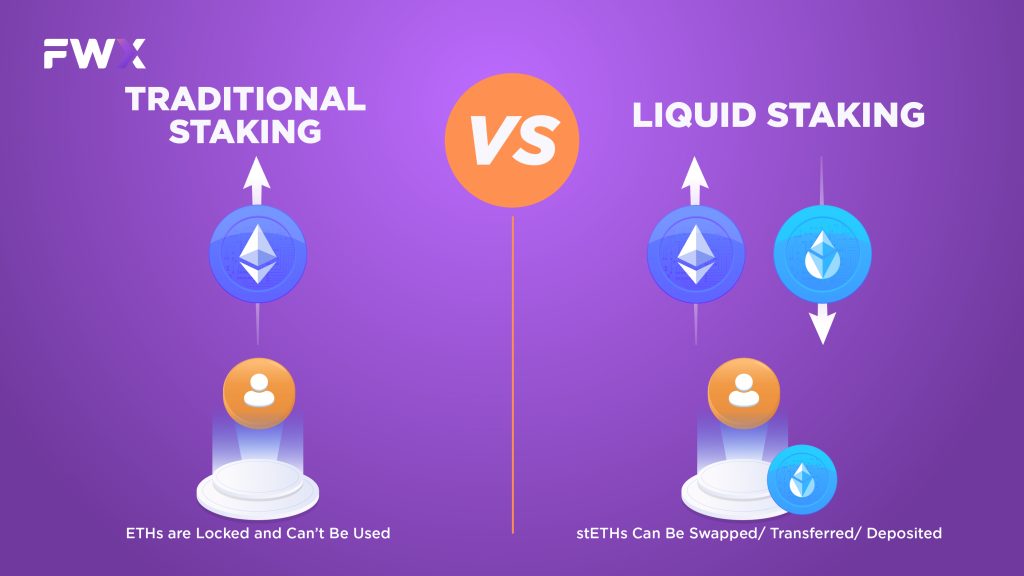Liquid staking revolutionizes the cryptocurrency landscape by offering participants a unique opportunity to earn staking rewards while maintaining asset liquidity. Unlike traditional staking methods, liquid staking enables users to stake their assets and receive liquid derivatives, facilitating seamless trading and participation in DeFi protocols. This article explores the advantages and risks of liquid staking, providing insights into its transformative potential in the crypto ecosystem.
What is Staking?

Staking is a process commonly associated with blockchain technology, particularly in networks that utilize the proof-of-stake (PoS) consensus mechanism. In simple terms, staking involves participants locking up a certain amount of cryptocurrency in a wallet to support the operations of a blockchain network. These participants, known as validators or stakers, then validate transactions and create new blocks on the blockchain.
Unlike the proof-of-work (PoW) consensus mechanism used by cryptocurrencies like Bitcoin, where miners solve complex mathematical puzzles to validate transactions and secure the network, PoS relies on validators who are chosen to create new blocks based on the amount of cryptocurrency they hold and are willing to “stake” as collateral.
The process of staking typically involves the following steps:
- Acquiring Cryptocurrency: Staking requires participants to own the cryptocurrency native to the blockchain network they wish to support.
- Setting Up a Wallet: Participants need to set up a digital wallet compatible with the specific cryptocurrency they plan to stake.
- Locking Up Funds: Participants transfer a certain amount of cryptocurrency from their wallet to a staking contract or address, effectively locking up these funds as collateral.
- Participating in Consensus: Validators are selected to create new blocks and validate transactions based on various factors, including the amount of cryptocurrency they have staked. Validators are rewarded with additional cryptocurrency for their efforts.
- Receiving Rewards: Validators earn staking rewards for their participation in the network. These rewards typically come in the form of additional cryptocurrency, which is distributed according to the network’s staking protocol.
What is Liquid Staking?

Liquid staking is an innovative concept that combines the benefits of staking with the liquidity of assets, allowing participants to earn staking rewards while maintaining the ability to use their cryptocurrency holdings for other purposes. In traditional staking, participants lock up their cryptocurrency in a staking contract, rendering it illiquid for the duration of the staking period. However, with liquid staking, participants can stake their assets and receive liquid staking derivatives (LSDs) in return, which represent their staked assets’ value. These derivatives can then be freely traded or used in decentralized finance (DeFi) protocols, providing users with enhanced flexibility and utility.
The process of liquid staking typically involves the following steps:
- Staking Assets: Participants transfer their cryptocurrency holdings to a liquid staking platform or smart contract, where they are staked to support the operations of a blockchain network.
- Receiving Derivatives: In exchange for staking their assets, participants receive liquid staking derivatives (LSDs), which represent their staked assets’ value and entitle them to staking rewards.
- Flexibility and Liquidity: Unlike traditional staking, where assets are locked up and illiquid, LSDs can be freely traded on decentralized exchanges or used as collateral in DeFi protocols, allowing participants to access their funds and earn additional returns simultaneously.
Traditional Staking vs. Liquid Staking

Traditional staking and liquid staking are two distinct approaches to participating in staking on blockchain networks, each offering unique advantages and considerations. Let’s compare these two methods:
Traditional Staking:
- Locking of Assets: In traditional staking, participants lock up their cryptocurrency assets in a staking contract or address to support the network and earn staking rewards. These assets become illiquid during the staking period and cannot be freely accessed or used for other purposes.
- Direct Staking Rewards: Validators in traditional staking receive staking rewards directly in the staked cryptocurrency. The rewards are typically distributed according to the network’s staking protocol and consensus mechanism.
- Security and Reliability: Traditional staking is generally considered secure and reliable, as it relies on established blockchain networks and consensus mechanisms. Participants contribute to network security and transaction validation by staking their assets.
- Limited Flexibility: One of the main drawbacks of traditional staking is the lack of flexibility and liquidity of staked assets. Participants must commit their assets for a specified staking period, limiting their ability to access funds or participate in other financial activities.
Liquid Staking:
- Maintaining Liquidity: It allows participants to stake their cryptocurrency assets while maintaining liquidity. Instead of locking up their assets, participants receive LSDs representing the value of their staked assets, which can be freely traded or used in DeFi protocols.
- Flexibility and Usability: It offers greater flexibility and usability of staked assets compared to traditional staking. Participants can access their funds and use them for various purposes, such as trading, lending, or providing liquidity in DeFi protocols, while still earning staking rewards.
- Risk Management: It enables participants to manage risks more effectively by diversifying their cryptocurrency holdings and utilizing their assets for multiple financial activities simultaneously. Participants can mitigate risks associated with price volatility or unforeseen events by maintaining liquidity.
- Smart Contract and Counterparty Risks: While it offers enhanced flexibility, it also introduces smart contract and counterparty risks. Participants must trust the underlying smart contracts or platforms where they stake their assets, as well as manage counterparty risks associated with centralized liquid staking providers.
Centralized vs. Decentralized Liquid Staking
Centralized and decentralized liquid staking represent two distinct approaches to participating in liquid staking, each with its own characteristics, benefits, and considerations. Let’s explore the differences between centralized and decentralized liquid staking:
Centralized Liquid Staking:
- Third-Party Intermediaries: Centralized liquid staking platforms or providers act as intermediaries between participants and the staking process. Participants stake their assets with these platforms, which manage the staking process on their behalf.
- Ease of Use: Centralized liquid staking platforms often offer user-friendly interfaces and streamlined processes, making it easier for participants to stake their assets and earn rewards without requiring extensive technical knowledge.
- Custodial Services: Participants in centralized liquid staking typically entrust their assets to the custody of the platform or provider, which manages the staking process and distributes rewards. This centralized custody introduces counterparty risks, as participants rely on the platform’s security and integrity.
- Regulatory Compliance: Centralized liquid staking platforms may need to comply with regulatory requirements and standards, depending on their jurisdiction and the services they offer. This regulatory oversight can provide participants with additional assurance and protection but may also limit the platform’s flexibility and accessibility.
- Potential for Higher Rewards: Centralized liquid staking platforms may offer higher staking rewards or additional incentives to attract participants, as they can leverage economies of scale and optimize the staking process.
Decentralized Liquid Staking:
- Smart Contracts and Protocols: Decentralized liquid staking operates on blockchain networks using smart contracts and decentralized protocols. Participants interact directly with these protocols without the need for intermediaries or third-party providers.
- Trustless Environment: Decentralized liquid staking eliminates the need for trust in centralized entities, as participants stake their assets directly with smart contracts and interact with decentralized protocols. This trustless environment enhances security and reduces reliance on single points of failure.
- Enhanced Privacy and Control: Participants in decentralized liquid staking retain full control and ownership of their assets throughout the staking process. They do not need to trust third parties with custody, reducing the risk of unauthorized access or loss of funds.
- Community Governance: Decentralized liquid staking protocols often incorporate community governance mechanisms, allowing participants to participate in decision-making processes related to protocol upgrades, parameter adjustments, and governance proposals.
- Technical Complexity: Decentralized liquid staking may require participants to have a deeper understanding of blockchain technology, smart contracts, and decentralized protocols. Interacting with decentralized platforms and managing private keys involves a higher level of technical complexity compared to centralized alternatives.
Benefits of Liquid Staking
Liquid staking presents several compelling benefits for cryptocurrency holders and participants in blockchain networks. Let’s delve into some of these advantages:
- Enhanced Liquidity: One of the primary benefits of liquid staking is the ability for participants to maintain liquidity while still earning staking rewards. Unlike traditional staking, where assets are locked up for a specific period, it allows participants to access their funds and use them for other purposes, such as trading, investing, or spending.
- Flexibility and Usability: LSDs received in exchange for staked assets can be freely traded on decentralized exchanges or used as collateral in DeFi protocols. This flexibility enables participants to leverage their staked assets for additional financial opportunities, such as borrowing, lending, or providing liquidity, while still earning staking rewards.
- Diversification: It allows participants to diversify their cryptocurrency holdings and investment strategies by staking multiple assets across different blockchain networks. By spreading their staked assets across various networks, participants can reduce risk exposure and optimize their portfolio for potential returns.
- Risk Management: It provides participants with greater control over their assets and risk management strategies. Participants can actively monitor market conditions and adjust their staked assets or investment allocations accordingly, mitigating risks associated with price volatility or unforeseen events.
- Participation: Liquid staking lowers barriers to entry for participating in staking and blockchain networks. By offering enhanced liquidity and usability of staked assets, it attracts a broader range of participants, including retail investors, institutional players, and DeFi enthusiasts, thereby promoting broader network participation and decentralization.
- Earning Potential: It enables participants to earn staking rewards while maintaining liquidity, allowing them to capitalize on the potential returns generated by blockchain networks. By actively participating in staking, participants contribute to network security, transaction validation, and governance processes, while also earning rewards for their efforts.
Risks and Limitations of Liquid Staking
While liquid staking offers numerous benefits, it also comes with its own set of risks and limitations that participants should be aware of before engaging in this activity. Here are some of the key risks and limitations associated with liquid staking:
- Smart Contract Risks: It relies on smart contracts to manage the staking process and issue LSDs. Smart contracts are susceptible to coding errors, vulnerabilities, and exploits, which could result in the loss of staked assets or manipulation of the staking rewards distribution.
- Counterparty Risks: Participating in liquid staking often involves trusting third-party platforms, exchanges, or protocols to manage the staking process and issue LSDs. These centralized entities may pose counterparty risks, such as custody issues, security breaches, or insolvency, which could result in the loss or theft of staked assets.
- Impermanent Loss: Participating in liquidity pools for liquid staking may expose participants to impermanent loss, where the value of their staked assets fluctuates compared to holding them directly. This loss occurs when the relative prices of the staked assets and their trading pairs change over time, impacting the overall value of the liquidity pool shares.
- Regulatory Uncertainty: The regulatory landscape surrounding liquid staking platforms, exchanges, and derivatives markets is still evolving and varies by jurisdiction. Participants may encounter regulatory challenges, compliance requirements, or legal uncertainties when engaging in liquid staking activities, which could affect the operation and accessibility of these platforms.
- Market Risks: Staking rewards and the value of LSDs are subject to market dynamics, including fluctuations in cryptocurrency prices, network conditions, and demand for staking services. Participants may experience reduced staking rewards or losses if the value of the staked assets declines or market conditions change unfavorably.
- Complexity: Participating in liquid staking requires a certain level of technical expertise and familiarity with decentralized platforms, protocols, and financial instruments. Participants must navigate complex processes, manage private keys, and understand the risks involved in interacting with decentralized ecosystems, which may pose challenges for less experienced users.
- Liquidity Risks: While it aims to provide enhanced liquidity for staked assets, participants may encounter liquidity risks when trading LSDs or participating in DeFi protocols. Thin order books, low trading volumes, or slippage may affect the liquidity and marketability of LSDs, impacting participants’ ability to buy, sell, or trade these assets efficiently.
Conclusion
In conclusion, liquid staking offers a promising avenue for cryptocurrency holders to maximize the utility of their assets while actively participating in blockchain networks. By combining the benefits of staking with enhanced liquidity and usability, it unlocks new opportunities for financial innovation and DeFi integration. However, participants must be aware of the associated risks and limitations, including smart contract vulnerabilities, counterparty risks, impermanent loss, regulatory uncertainty, market risks, and complexity. Despite these challenges, it represents a valuable tool for optimizing investment strategies and engaging with decentralized ecosystems in the dynamic cryptocurrency landscape. With careful consideration and risk management, participants can leverage the benefits of liquid staking to navigate the evolving crypto markets effectively.


